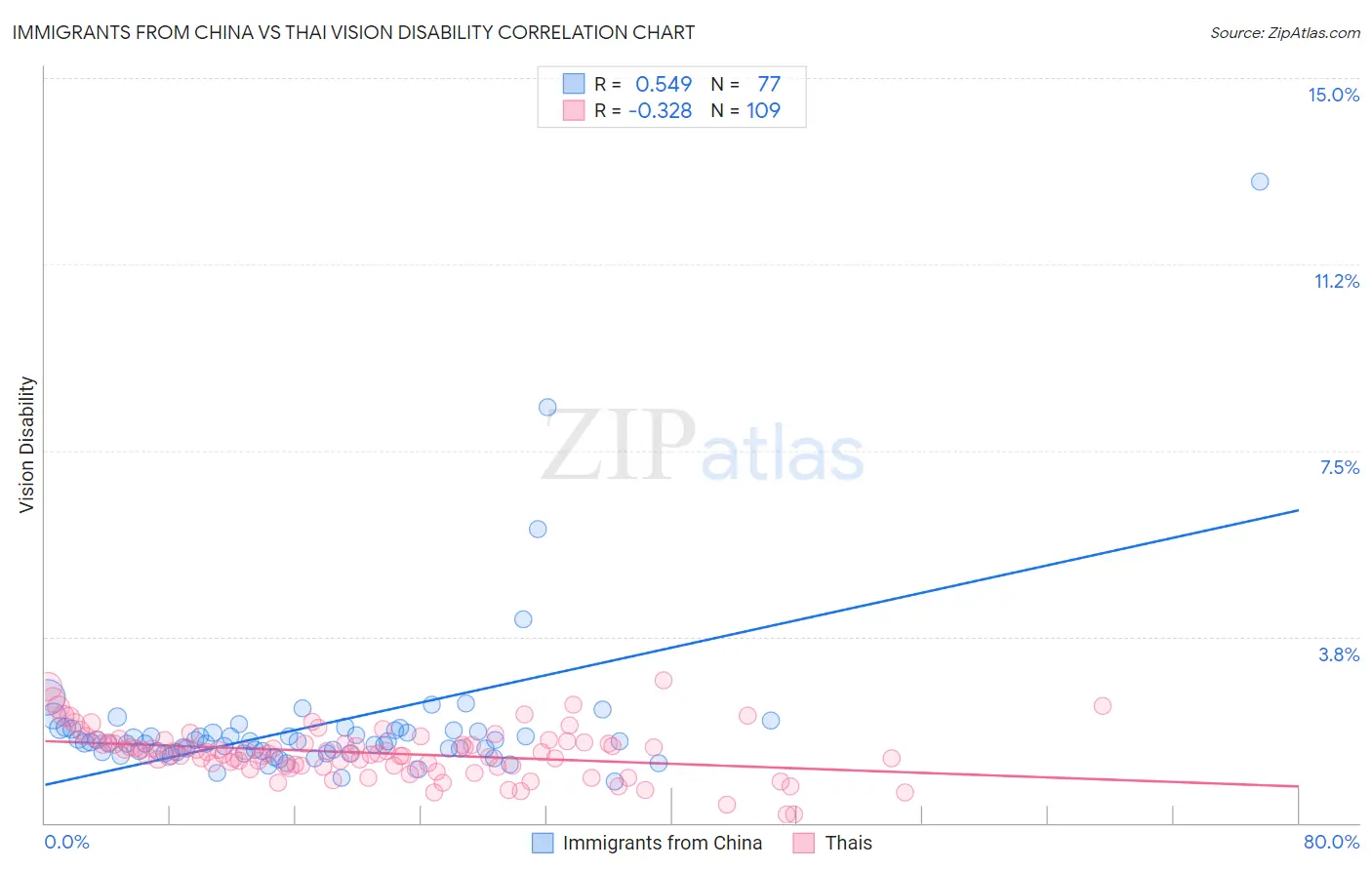Immigrants from China vs Thai Vision Disability
COMPARE
Immigrants from China
Thai
Vision Disability
Vision Disability Comparison
Immigrants from China
Thais
1.8%
VISION DISABILITY
100.0/ 100
METRIC RATING
14th/ 347
METRIC RANK
1.7%
VISION DISABILITY
100.0/ 100
METRIC RATING
4th/ 347
METRIC RANK
Immigrants from China vs Thai Vision Disability Correlation Chart
The statistical analysis conducted on geographies consisting of 456,538,293 people shows a substantial positive correlation between the proportion of Immigrants from China and percentage of population with vision disability in the United States with a correlation coefficient (R) of 0.549 and weighted average of 1.8%. Similarly, the statistical analysis conducted on geographies consisting of 475,304,455 people shows a mild negative correlation between the proportion of Thais and percentage of population with vision disability in the United States with a correlation coefficient (R) of -0.328 and weighted average of 1.7%, a difference of 5.3%.

Vision Disability Correlation Summary
| Measurement | Immigrants from China | Thai |
| Minimum | 0.84% | 0.17% |
| Maximum | 12.9% | 2.9% |
| Range | 12.1% | 2.7% |
| Mean | 1.9% | 1.4% |
| Median | 1.6% | 1.4% |
| Interquartile 25% (IQ1) | 1.4% | 1.2% |
| Interquartile 75% (IQ3) | 1.9% | 1.6% |
| Interquartile Range (IQR) | 0.43% | 0.47% |
| Standard Deviation (Sample) | 1.6% | 0.49% |
| Standard Deviation (Population) | 1.6% | 0.48% |
Demographics Similar to Immigrants from China and Thais by Vision Disability
In terms of vision disability, the demographic groups most similar to Immigrants from China are Immigrants from Eastern Asia (1.8%, a difference of 0.15%), Immigrants from Korea (1.8%, a difference of 0.22%), Immigrants from Bolivia (1.8%, a difference of 0.42%), Immigrants from Israel (1.8%, a difference of 0.45%), and Indian (Asian) (1.8%, a difference of 0.87%). Similarly, the demographic groups most similar to Thais are Okinawan (1.8%, a difference of 1.9%), Immigrants from Iran (1.8%, a difference of 2.5%), Immigrants from South Central Asia (1.8%, a difference of 2.6%), Immigrants from Taiwan (1.7%, a difference of 2.6%), and Iranian (1.8%, a difference of 2.7%).
| Demographics | Rating | Rank | Vision Disability |
| Immigrants | India | 100.0 /100 | #1 | Exceptional 1.7% |
| Filipinos | 100.0 /100 | #2 | Exceptional 1.7% |
| Immigrants | Taiwan | 100.0 /100 | #3 | Exceptional 1.7% |
| Thais | 100.0 /100 | #4 | Exceptional 1.7% |
| Okinawans | 100.0 /100 | #5 | Exceptional 1.8% |
| Immigrants | Iran | 100.0 /100 | #6 | Exceptional 1.8% |
| Immigrants | South Central Asia | 100.0 /100 | #7 | Exceptional 1.8% |
| Iranians | 100.0 /100 | #8 | Exceptional 1.8% |
| Immigrants | Singapore | 100.0 /100 | #9 | Exceptional 1.8% |
| Immigrants | Hong Kong | 100.0 /100 | #10 | Exceptional 1.8% |
| Immigrants | Israel | 100.0 /100 | #11 | Exceptional 1.8% |
| Immigrants | Korea | 100.0 /100 | #12 | Exceptional 1.8% |
| Immigrants | Eastern Asia | 100.0 /100 | #13 | Exceptional 1.8% |
| Immigrants | China | 100.0 /100 | #14 | Exceptional 1.8% |
| Immigrants | Bolivia | 100.0 /100 | #15 | Exceptional 1.8% |
| Indians (Asian) | 100.0 /100 | #16 | Exceptional 1.8% |
| Burmese | 100.0 /100 | #17 | Exceptional 1.8% |
| Bolivians | 100.0 /100 | #18 | Exceptional 1.9% |
| Immigrants | Sri Lanka | 100.0 /100 | #19 | Exceptional 1.9% |
| Asians | 100.0 /100 | #20 | Exceptional 1.9% |